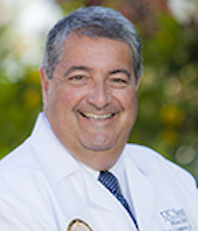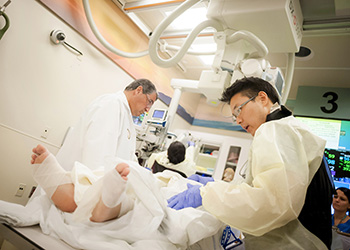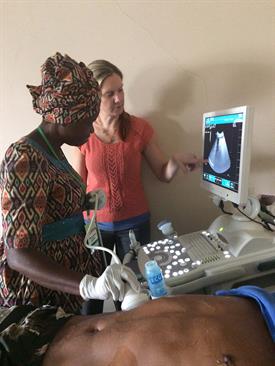Q & A with Raul Coimbra
 Raul Coimbra, MD, PhD, is an internationally recognized trauma surgeon who specializes in trauma, surgical critical care and acute care surgery. He is the surgeon-in-chief of UC San Diego Medical Center in Hillcrest and the director of the UCSD Level 1 Trauma Center. In this interview he discusses global trauma care; the controversy surrounding the shooting and subsequent care of Rep. Steve Scalise, and how he and others built the UCSD Trauma Center.
Raul Coimbra, MD, PhD, is an internationally recognized trauma surgeon who specializes in trauma, surgical critical care and acute care surgery. He is the surgeon-in-chief of UC San Diego Medical Center in Hillcrest and the director of the UCSD Level 1 Trauma Center. In this interview he discusses global trauma care; the controversy surrounding the shooting and subsequent care of Rep. Steve Scalise, and how he and others built the UCSD Trauma Center.
September 1, 2017 | Interview by Lindsay Morgan
You completed your residency in general and peripheral vascular surgery at the Santa Casa School of Medicine in Sao Paulo, Brazil, where you also earned your medical and doctoral degree. How did you get interested in trauma surgery?
My mentors in medical school, who were very skilled surgeons, offered me the opportunity to go into the operating room since my first year in medical school. I later developed a passion for emergency surgery, which led me to trauma. I focused my training in general surgery and vascular surgery but in fact I did vascular surgery to become a better trauma surgeon.
Since joining UCSD in 1998, you have played a huge role in building UCSD's Level-1 Trauma Center, and in the San Diego Trauma System, which is now one of the top programs in the nation, and a model for trauma centers around the world. What was it like to join the team?
 I had big shoes to fill. The trauma system in San Diego was developed in 1984, so my involvement in the first 10 years or so was nonexistent. The kudos go to Drs. David Hoyt and Steve Shackford, who were the pioneers of the trauma center and the trauma system in San Diego county.
I had big shoes to fill. The trauma system in San Diego was developed in 1984, so my involvement in the first 10 years or so was nonexistent. The kudos go to Drs. David Hoyt and Steve Shackford, who were the pioneers of the trauma center and the trauma system in San Diego county.
I joined as an associate professor in 1998, and a few years later, became the director of the surgical ICU and director of the surgical critical care fellowship program. In 2006, when Dr. Hoyt left to become the chair of surgery at UC Irvine, I became the division chief and trauma director. It was already an outstanding program, with tremendous national and international visibility when I took over.
What have been your most important achievements since 2006?
Our collaboration with physicians from overseas has been a highlight. We developed an international observership program that lasted 12 years with more than 200 individuals benefitting from didactic sessions in trauma center organization; trauma flow; trauma care; and trauma quality improvement. The program was sought after by international physicians, who would go back to their home countries and build similar programs.
The other significant accomplishment was building a robust group of faculty. Everyone who is part of the current faculty group was recruited by me. They are the best asset we have.
This past June, after Rep. Steve Scalise was shot during baseball practice in Washington DC, he was taken to a trauma center. He survived, but developed an infectious complication during his recovery, which led to USA Today to question why he was taken to that trauma center vs. other non-trauma centers that had better Leapfrog grades for infection rates. What do you make of that? Was USA Today right?
He would not have survived if he had not gone to a trauma center. Trauma centers are designed to take care of the most severe patients: they have blood banks, radiology, experienced surgeons available 24/7, ICU care. Regular hospitals go to sleep at night, whereas the trauma center is awake. That's why he survived. The Leapfrog score is one measure of quality that may reflect some institutional commitment to certain measures. But it has nothing to do with quality in trauma care. The fact that he had an infection was a good thing because he had to be alive to have an infection. If he had gone to another center that didn't have the resources of a trauma center he probably would have died in his first or second day at the hospital.
Trauma is the leading cause of death globally in people under age 50 and creates a huge burden on health systems, especially in resource-constrained countries. You are president of the World Coalition for Trauma Care; hold membership and leadership positions with the World Health Organization and other global bodies; and you've done a lot of work overseas . What are some of the challenges in providing trauma care in other countries—particularly in low-income countries?
When we think about low-income countries, we always think about resources, but the lack of resources is not the main problem. The main problem is lack of education. In the World Coalition for Trauma Care, and in the trauma program at UCSD, we have focused on education: trauma center buildup, data collection, quality improvement; and protocol development. That's the first step.
The second step is obviously resource generation. We cannot go to a sub-Saharan African country and provide an economic solution for their problems. Those solutions have to come from within. Our job is to provide the foundation—with education, data collection, data analysis—to allow them to demonstrate that injury is a significant healthcare problem that needs investment.
Can you give me an example of a program you've been involved in that focuses on education in low-income countries?
A great example is the work we've participated in with the Pan-American Trauma Society (PTS), developing trauma standards, trauma registries, and trauma quality improvement processes in every country in Latin America. If it were not for the work of PTS, we would not have achieved the degree of success that we have. Every country in Latin America provides better trauma care than 10 or 15 years ago because of that process.
 Our work in Ghana, which is led by Allison Berndtson and is a partnership with the Cape Coast University, is another example of an opportunity to affect how care is provided, how data is collected, how data is interpreted, so they can use it to their own advantage.
Our work in Ghana, which is led by Allison Berndtson and is a partnership with the Cape Coast University, is another example of an opportunity to affect how care is provided, how data is collected, how data is interpreted, so they can use it to their own advantage.
Have you seen examples of trauma systems that are doing things differently from the U.S. model—an innovation that we would never think to do here, but is working?
My experience helping to develop trauma systems in Korea and Japan suggests that even high-income countries don't have the organizational infrastructure and resources that we have in the United States. So they have developed their own solutions to trauma center designation, and have different ways of providing care. If we try to transplant our system into their system, it's not gonna work. There are cultural differences, and multiple healthcare delivery systems differences. The same is true for low-income countries. It is amazing to go to LICs and see how much they do with so little, and still are able to have very reasonable outcomes.
At the policy level, what are some of the most important advances in global trauma care that have taken place over the last decade?
At a global level, increased awareness of injury as an important healthcare problem was pretty remarkable. And that has to do with a combination of factors: WHO standards—the World Health Assembly passed a resolution on trauma in 2007, which affects every country in the world; and organizations like the World Coalition for Trauma Care bringing people together every two years, having a forum to discuss issues and share potential solutions has had a significant impact.
There has also been a major shift in the way we resuscitate trauma patients. Until ten years ago, we used to give IV fluids to trauma patients who were bleeding in an attempt to maintain their blood pressure. We learned from the military that the right way to resuscitate patients who are bleeding to death is to give them blood early on and focus on controlling the bleeding rather than on giving IV fluids. This paradigm shift has caught on globally, and has helped to save many lives.
There have been some dramatic global political shifts over the last couple of years, with potential impacts on global health investments. What do you worry about most for the future?
Funding is always a limiting factor for any of us who has a passion for global health. The U.S. advantage in this field is obviously the amount of resources that we have, and cuts in the federal budget are worrisome. Cuts to the NIH budget, for example, will affect the Fogarty Foundation, which funds development and research programs in low-income countries, and has a global trauma mechanism every five years, which will be disappearing.
But it's interesting that the US has always contributed with money, whereas global health as a strategy for U.S. medical schools and professional organizations is not well-established. It's something that has developed in the last decade or so whereas many universities in Europe and some in Asia have been doing global health work for much longer. We are a little behind.
What about your time at UCSD – 20 years – has most influenced your career?
I was blessed to be mentored by phenomenal individuals, particularly Dr. Hoyt, and to have had the opportunity to lead this program now for almost 12 years. Also, the opportunity to lead the private component of a public-private partnership, which is the design of the San Diego Trauma System, has been an amazing experience. We are the only specialty in medicine in this county that doesn't compete for patients. We're friends with other healthcare networks, not enemies. We have demarcated catchment areas, we don't need to compete. We work together with one and only one goal: to improve trauma care for the community of this county.
